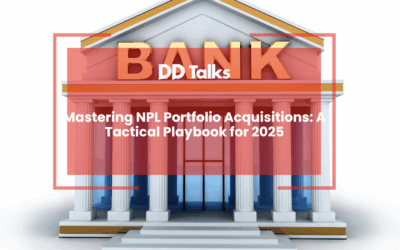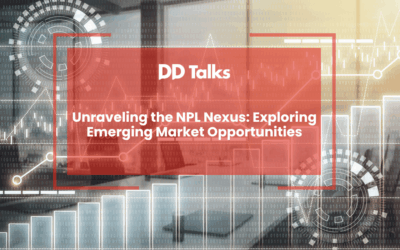Key Takeaways
- Fintech innovations have transformed NPL management, reducing resolution timelines from years to months and improving recovery rates by 20-30% compared to traditional methods.
- Digital platforms have automated NPL workflows, reducing operational costs by up to 40% while improving accuracy and enabling real-time collaboration between stakeholders.
- Advanced data analytics and AI applications have enhanced NPL portfolio performance, with predictive models improving recovery rate forecasts by up to 25% and automated systems increasing successful contact rates by over 35%.
- Blockchain technology has introduced unprecedented transparency to NPL markets, reducing transaction costs by up to 25% and improving settlement times by over 70%.
- Digital marketplaces have democratized NPL trading, creating more liquid markets and allowing smaller institutions to access the same investor networks as larger banks.
- Mobile solutions have transformed borrower engagement, with well-designed interfaces increasing voluntary payment rates by up to 40%.
- Open banking frameworks are enabling more comprehensive borrower assessments and fostering integrated NPL ecosystems with specialized service providers.
- As European banks still carry approximately €300 billion in NPLs, these fintech solutions have become essential rather than optional for forward-thinking financial institutions.
Fintech Disruption: Innovative NPL Solutions Reshaping the Landscape
The European banking sector has witnessed a significant transformation in how non-performing loans (NPLs) are managed, traded, and resolved. Fintech innovations are revolutionising this traditionally paper-heavy, manual domain, bringing efficiency, transparency, and accessibility to NPL management. With European banks still carrying approximately €300 billion in NPLs as of 2023, the need for innovative solutions has never been more pressing. This comprehensive analysis explores how cutting-edge technologies are reshaping the NPL landscape, from AI-powered assessment tools to blockchain-secured transactions and mobile-first recovery platforms. As regulatory pressures mount and margins tighten, these fintech solutions are becoming essential rather than optional for forward-thinking financial institutions across Europe.
Table of Contents
- The Evolution of NPL Management Through Fintech Innovation
- How Digital Platforms Are Transforming NPL Workflows
- Leveraging Data Analytics for Enhanced NPL Performance
- AI Applications Revolutionizing NPL Assessment and Recovery
- Blockchain Technology: Securing Transparency in NPL Markets
- Exploring NPL Online Marketplaces and Trading Platforms
- Mobile Solutions: Bringing NPL Management to Your Fingertips
- Open Banking and Its Impact on NPL Ecosystem Development
The Evolution of NPL Management Through Fintech Innovation
The NPL management landscape has undergone a remarkable transformation over the past decade. Traditional approaches involving manual documentation, siloed information systems, and labour-intensive recovery processes are rapidly giving way to integrated digital solutions. This evolution has been accelerated by the aftermath of the 2008 financial crisis and subsequent European banking regulations that demanded more efficient NPL resolution frameworks.
Modern NPL fintech solutions have evolved from simple database management systems to comprehensive platforms that handle the entire NPL lifecycle. Early innovations focused primarily on digitising existing processes, while today’s solutions leverage advanced technologies to reimagine the entire NPL management paradigm. The European Central Bank’s guidance on NPLs has further catalysed this transformation, pushing banks to adopt more sophisticated tools for NPL portfolio management.
This evolution is particularly evident in markets like Italy, Spain, and Greece, where high NPL volumes necessitated innovative approaches. Banks that have embraced fintech solutions report significant improvements in recovery rates—some achieving 20-30% better outcomes than traditional methods. The integration of digital NPL servicing tools has reduced resolution timelines from years to months in many cases, demonstrating the tangible benefits of technological adoption in this space.
How Digital Platforms Are Transforming NPL Workflows
Digital platforms have fundamentally restructured NPL workflows, replacing fragmented legacy systems with integrated environments that streamline every aspect of NPL management. These NPL digital platforms centralise documentation, automate compliance checks, and facilitate seamless communication between stakeholders—from loan servicers to investors and legal teams.
Workflow automation stands as perhaps the most significant contribution of these platforms. Tasks that previously required days of manual processing can now be completed in hours or even minutes. For instance, document verification that once took weeks can now be accomplished through automated systems with optical character recognition and digital signature verification. This process automation has reduced operational costs by up to 40% for some European banks while simultaneously improving accuracy.
Another transformative aspect is the enhanced collaboration these platforms enable. Cloud-based NPL management systems allow multiple parties to access and update information in real-time, eliminating information silos that plagued traditional NPL management. This collaborative approach is particularly valuable in cross-border NPL transactions, which have historically been complicated by differing regulatory requirements and documentation standards. Digital platforms now leverage AI and analytics for better outcomes in distressed loan management, creating a more efficient ecosystem for all participants.
Leveraging Data Analytics for Enhanced NPL Performance
Data analytics has emerged as a cornerstone of modern NPL management, transforming how financial institutions evaluate, price, and resolve non-performing assets. Advanced NPL data analytics tools now process vast quantities of structured and unstructured data to extract actionable insights that were previously inaccessible through manual analysis.
Predictive analytics has revolutionised NPL portfolio management by enabling more accurate forecasting of recovery probabilities and timelines. By analysing historical performance data alongside macroeconomic indicators, these systems can predict which recovery strategies are likely to yield optimal results for specific loan categories. Some European banks report improvements in recovery rate predictions of up to 25% when implementing these analytical models.
Performance tracking has likewise been transformed through real-time analytics dashboards that provide comprehensive visibility into NPL portfolio metrics. These tools enable portfolio managers to identify underperforming segments quickly and adjust strategies accordingly. The integration of external data sources—such as property valuations, court proceeding timelines, and regional economic indicators—further enhances the predictive power of these analytical systems. NPL valuation tools powered by advanced analytics have become particularly valuable in competitive bidding scenarios, where accurate pricing can make the difference between profitable and unprofitable acquisitions.
AI Applications Revolutionizing NPL Assessment and Recovery
Artificial intelligence represents perhaps the most disruptive force in the NPL management landscape, with applications spanning from initial loan assessment to recovery optimisation. Machine learning algorithms now analyse borrower behaviour patterns to identify early warning signs of potential defaults, allowing for proactive intervention before loans become non-performing.
In the assessment phase, AI-powered NPL applications evaluate loan documentation with unprecedented speed and accuracy. Natural language processing (NLP) systems can extract relevant information from unstructured documents, identify discrepancies, and flag potential compliance issues. This capability is particularly valuable when dealing with legacy NPL portfolios that often contain inconsistent or incomplete documentation.
For recovery processes, AI systems optimise contact strategies by determining the most effective communication channels, timing, and messaging for each borrower. These systems continuously learn from interaction data, refining their approaches to maximise engagement and resolution rates. Some advanced platforms even employ sentiment analysis to gauge borrower receptiveness and adjust negotiation strategies accordingly. The implementation of automated debt recovery systems guided by AI has enabled some servicers to increase successful contact rates by over 35% while reducing operational costs associated with recovery efforts.
Blockchain Technology: Securing Transparency in NPL Markets
Blockchain technology is addressing one of the most persistent challenges in NPL markets: trust and transparency. By creating immutable records of loan documentation, ownership history, and transaction details, blockchain NPL solutions establish a single source of truth that all parties can rely upon. This technological foundation is particularly valuable in markets where documentation gaps and ownership uncertainties have historically complicated NPL transactions.
Smart contracts represent a particularly promising application of blockchain in the NPL space. These self-executing contracts with coded terms can automate complex NPL transactions, ensuring that all conditions are met before transfers occur. For instance, a smart contract might automatically verify regulatory compliance, confirm payment receipt, and transfer loan documentation upon completion of an NPL sale. This automation reduces settlement times from weeks to days or even hours in some cases.
The transparency afforded by blockchain also facilitates more efficient due diligence processes. Potential investors can access comprehensive, verified loan histories through permissioned blockchain networks, significantly reducing the time and cost associated with portfolio evaluation. Several European banks have piloted blockchain-based NPL trading platforms, reporting reductions in transaction costs of up to 25% and settlement time improvements of over 70%. As regulatory technology for NPLs continues to evolve, blockchain’s role in ensuring compliance while streamlining processes appears increasingly central to the future of NPL markets.
Exploring NPL Online Marketplaces and Trading Platforms
Digital marketplaces have transformed how NPLs are bought and sold, creating more liquid, accessible, and efficient trading environments. These NPL online marketplaces connect sellers with a broader pool of potential buyers, including specialised investors who might previously have been excluded from traditional NPL transactions due to scale or relationship limitations.
Modern NPL transaction platforms offer sophisticated tools for portfolio segmentation, allowing sellers to package loans in ways that maximise appeal to different investor types. Simultaneously, buyers benefit from standardised data presentation and analytical tools that facilitate more informed bidding decisions. The resulting competition typically leads to improved pricing for sellers while giving buyers access to more diverse investment opportunities.
These platforms have been particularly transformative for smaller financial institutions that previously lacked the resources to efficiently market NPL portfolios to international investors. By providing standardised processes and documentation templates, these marketplaces level the playing field, allowing regional banks to access the same investor networks as their larger counterparts. The European NPL marketplace ecosystem has matured significantly, with several platforms now specialising in specific asset classes or regional markets, further enhancing matching efficiency between buyers and sellers.
Mobile Solutions: Bringing NPL Management to Your Fingertips
Mobile technology has extended the reach and responsiveness of NPL management systems, enabling stakeholders to monitor and manage portfolios from anywhere. NPL mobile apps provide real-time updates on portfolio performance, alert users to critical developments, and facilitate immediate action when necessary. This mobility has proven particularly valuable during the COVID-19 pandemic, when remote work became essential across the financial services industry.
For borrowers, mobile solutions have transformed the repayment experience. User-friendly NPL mobile apps now offer self-service options for reviewing loan status, exploring settlement options, and making payments. These applications typically incorporate behavioural design elements that encourage engagement and resolution, such as progress visualisations and achievement recognition. Some platforms report increases in voluntary payment rates of up to 40% following the implementation of well-designed mobile interfaces.
Field agents and recovery specialists likewise benefit from mobile tools that provide comprehensive borrower information, documentation access, and communication capabilities while on location. These mobile solutions enable more productive borrower meetings by ensuring all relevant information is readily available. The integration of geolocation features further enhances efficiency by optimising route planning for in-person visits and providing contextual information about local economic conditions that might affect recovery strategies.
Open Banking and Its Impact on NPL Ecosystem Development
Open banking frameworks are creating new possibilities for NPL management by enabling secure data sharing between financial institutions and authorised third parties. This connectivity facilitates more comprehensive borrower assessments, as NPL managers can access current financial information rather than relying solely on historical data. The resulting insights enable more personalised and realistic restructuring proposals that account for borrowers’ actual financial circumstances.
For NPL investors and servicers, open banking provides unprecedented visibility into portfolio performance and borrower behaviour. API connections allow for continuous monitoring of key indicators, enabling early intervention when warning signs appear. This real-time visibility represents a significant advancement over traditional approaches that relied on periodic, often outdated reporting.
Perhaps most significantly, open banking is fostering the development of integrated NPL ecosystems where specialised service providers can seamlessly connect with core management platforms. This modular approach allows financial institutions to assemble customised NPL management solutions that combine best-in-class components rather than accepting the limitations of monolithic systems. As open banking adoption continues to accelerate across Europe, its impact on NPL management is likely to deepen, particularly in areas such as automated income verification, payment processing, and financial health monitoring—all critical components of effective NPL resolution strategies.
Frequently Asked Questions
What are the main fintech innovations transforming NPL management?
The main fintech innovations transforming NPL management include AI-powered assessment tools, blockchain technology for transparent transactions, digital marketplaces for trading, data analytics platforms for performance tracking, mobile applications for on-the-go management, and open banking integrations. These technologies have reduced operational costs by up to 40% while improving recovery rates by 20-30% compared to traditional methods.
How does artificial intelligence improve NPL recovery rates?
Artificial intelligence improves NPL recovery rates by analyzing borrower behavior patterns to identify early warning signs, optimizing contact strategies through determining effective communication channels and timing, extracting relevant information from unstructured documents, and continuously learning from interaction data. Some servicers have increased successful contact rates by over 35% while reducing operational costs through AI-guided automated debt recovery systems.
What benefits do blockchain solutions offer for NPL transactions?
Blockchain solutions offer several benefits for NPL transactions: creating immutable records of loan documentation and ownership history, establishing a single source of truth for all parties, automating complex transactions through smart contracts, reducing settlement times from weeks to hours, facilitating more efficient due diligence, and reducing transaction costs by up to 25% while improving settlement time by over 70%.
How are digital marketplaces changing NPL trading?
Digital marketplaces are changing NPL trading by connecting sellers with a broader pool of potential buyers, offering sophisticated tools for portfolio segmentation, standardizing data presentation, providing analytical tools for informed bidding, leveling the playing field for smaller financial institutions, and creating more liquid, accessible, and efficient trading environments with improved pricing for sellers.
What role does open banking play in NPL management?
Open banking plays a crucial role in NPL management by enabling secure data sharing between financial institutions and authorized third parties, facilitating comprehensive borrower assessments using current financial information, providing real-time visibility into portfolio performance through API connections, enabling early intervention when warning signs appear, and fostering integrated NPL ecosystems where specialized service providers can seamlessly connect with core management platforms.
How have mobile solutions impacted borrower engagement in NPL resolution?
Mobile solutions have significantly impacted borrower engagement in NPL resolution by offering self-service options for reviewing loan status and settlement options, incorporating behavioral design elements that encourage engagement, providing convenient payment methods, enabling real-time communication, and delivering personalized repayment plans. These user-friendly applications have increased voluntary payment rates by up to 40% through improved accessibility and experience.
What data analytics capabilities are most valuable for NPL portfolio management?
The most valuable data analytics capabilities for NPL portfolio management include predictive analytics for forecasting recovery probabilities, real-time performance tracking dashboards, integration of external data sources (property valuations, court proceedings, economic indicators), advanced NPL valuation tools for accurate pricing, portfolio segmentation analytics, and early warning systems that identify potential defaults before they occur.




0 Comments